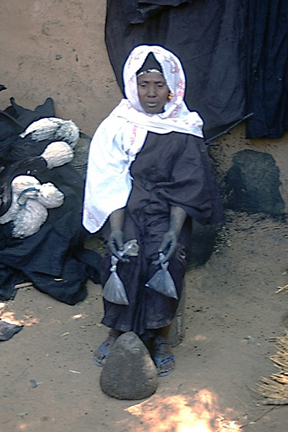
Indigo Blues
Children pulled me along the path between the narrow, winding maze of walls behind which families and their goats and chickens lived, where boys pumped bellows into their blacksmith fathers’ forges and vats of indigo waited in ferment for skeins of cotton yarn.
On market day, the village square grew busy. I found onions and tomato paste and live chickens for sale. Small vendors traded produce and gossip and the square filled with hundreds of women wrapped in indigo-dyed cloth. The women’s shoulders glistened in the sun. Their gesturing hands were stained deep blue, nails and cuticles black from dye. They had cooked, eaten, slept, made love, delivered babies, and—each day—bathed their hands in vats of midnight to dye home-spun thread and woven cloth.
I bought two lengths and wrapped both around me for a night’s sleep. I awoke the following morning navy blue. On African skin, freshly dyed indigo cloth bleeds and burnishes into a luster. My pink body absorbed the pigment like tattoo ink.
I stared down and gasped, then started to laugh, then laughed loudly and too close to hysteria. My blueness was on the outside, but inside, too. Laughter wedged open a crack in my emotional firewall and I started to cry, then stopped. I imagined looking down at young Tariq’s hazel eyes looking up into mine. What had I done?
Rachel Hoffman’s stories have appeared in Left Bank and Yellow Silk (both now defunct), and recently in Literary Bohemian, 1966 Journal, and Hot Metal Bridge—the submission a chapter from her unpublished memoir of Africa, chosen for the journal’s creative non-fiction Social Justice Prize. Her debut novel, Packer and Jack, was awarded an Oregon Literary Fellowship for a novel-in-progress and published by a small press in 2014.

